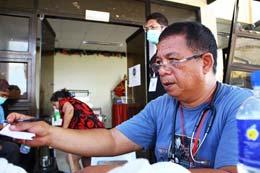Volunteers make a difference

Volunteers are making a difference in the central Philippines, after Typhoon Haiyan slammed into the region just over one week ago, leaving more than 4 million people displaced and thousands reported dead.
Francis Cinco, 28, who saw many dead bodies in his street in Tacloban after the storm, knew almost instinctively he had to take action at once. “I went to the city hall and volunteered to organize a search and rescue team,” the third-year law student said. “After an hour had passed, we were able to pick up at least 10 bodies and put them on our truck.”
Shortly after the storm struck on 8 November, aid agencies began arriving in the badly damaged city, where Cinco met a foreign aid worker from the Agency for Technical Cooperation and Development (ACTED), a Paris-based NGO. He hasn’t stopped since. “I want to be able to work as a volunteer so I can help my fellow Taclobans,” Cinco said. “I’m in it for the long haul.”
Although there are no exact figures for the number of volunteers now working in nine typhoon-affected regions, local aid workers estimate there are several hundred. “We’re very thankful to the volunteers,” said Tecson Lim, Tacloban’s city administrator. “Your presence alone is already enough for us to be strong.”
A growing number of volunteers have come to the city, with many arriving from various parts of the country in large groups. Gary Larosa, a doctor and government health officer in his early 50s, was at a mall shopping with his family in Davao City the day after the storm when he received the call.
“I was told by my supervisor to be ready by Monday [11 November] because a group of volunteer medical teams would be organized to help in the emergency and rescue operation,” Larosa said outside a recently establish medical clinic in Tacloban. “Shortly afterwards I received another call saying we needed to leave that night and I had just three hours to prepare,” he said.
Within hours there were 57 of them - five doctors, including himself, along with nurses, emergency medical personnel, and social workers - in a convoy consisting of several ambulances, trucks and other vehicles, heading to Tacloban, a distance of nearly 500km, Larosa said. The journey was treacherous as the main roads were littered with debris.
Larosa had taken part in another volunteer medical response effort for victims of Typhoon Bopha nearly one year earlier, which left nearly 2,000 killed or missing in the provinces of Compostela Valley, Davao Oriental and Davao del Norte, all in Mindanao region.
“It’s the same scene of destruction and people that needed an immediate medical help,” Larosa said. “It was sad to see a lot of people suffering.”
Patrick Fuller, a spokesperson for the International Federation of the Red Cross (IFRC) said there was a lot to be done in the typhoon-struck city, such as trauma counselling, treating hypertension among the elderly and tending to the many wounded people.
Of major concern are the “unhealthy conditions” of those in the city’s sports complex, the largest evacuation centre in the city, described by some as “a pit of suffering” where more than 8,000 displaced people are being housed.
Over 400,000 are staying in more than 1,500 evacuation centres, and the rest are staying with family and friends, the Philippine National Disaster Risk Reduction and Management Council reported on 19 November.
“There have been a lot of volunteers and for us and that is a huge advantage,” Fuller told IRIN, adding that in this city alone there were already 136 Red Cross-affiliated volunteers. “These guys are doing extraordinary jobs,” he said, even though many of the volunteers were themselves victims of the typhoon.
Matthew Cochrane, a spokesman for the UN Office for the Coordination of Humanitarian Affairs (OCHA), said 2.5 million people are in need of immediate food assistance.
Some 62 international humanitarian groups and NGOs are helping in the emergency response effort in the city and the outlying towns that can now been reached by road. Initially, piles of debris and toppled power lines had barred roads, but efforts to address that are improving, the OCHA official said.
“It was difficult in the beginning for the government or private groups, but some of the roads are clear now. We have access to fuel, vehicles are coming in every day and the airport is open,” Cochrane said, adding this would mean more food aid could arrive in the city.
Leave a comment









